#Diego de Siloe
Explore tagged Tumblr posts
Text

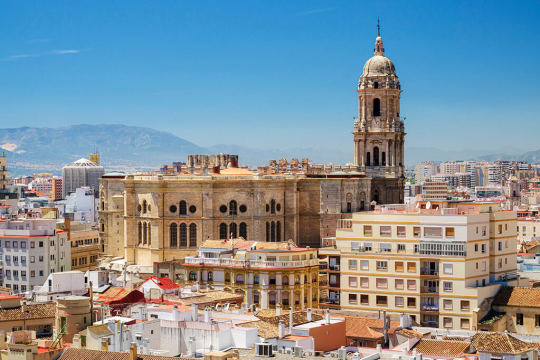

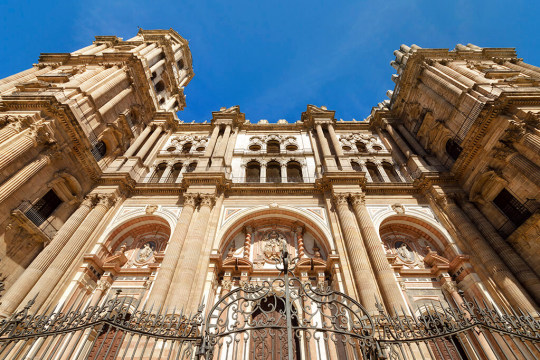
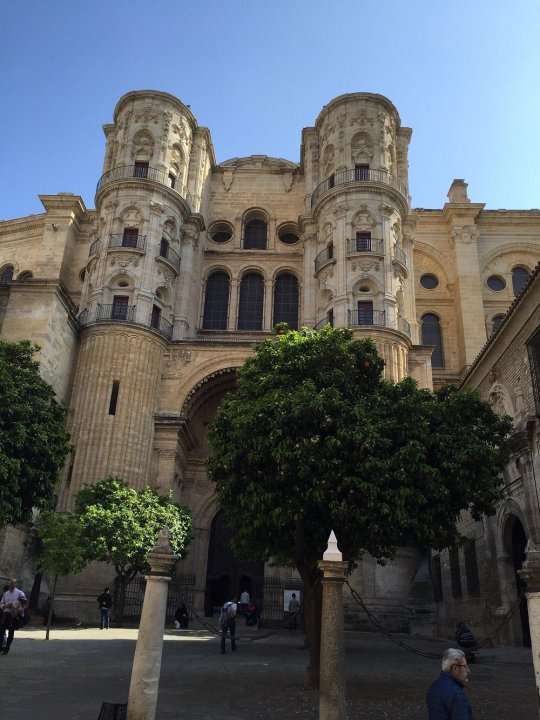

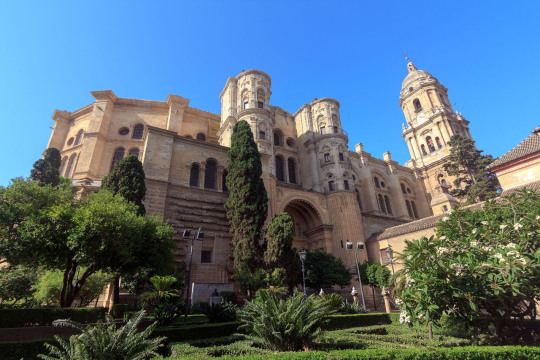
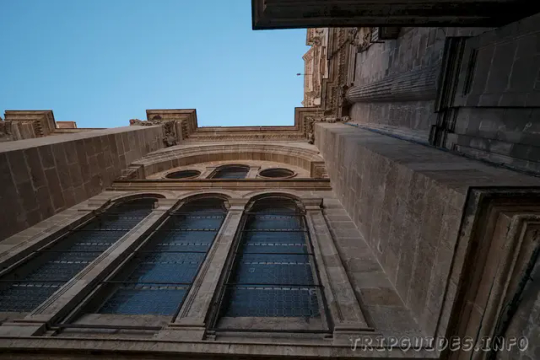
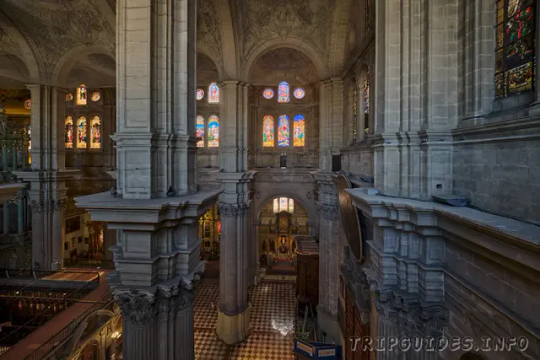
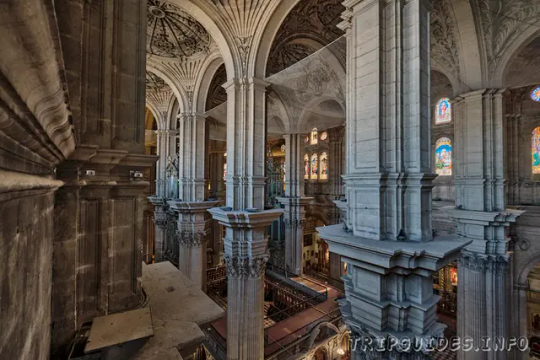
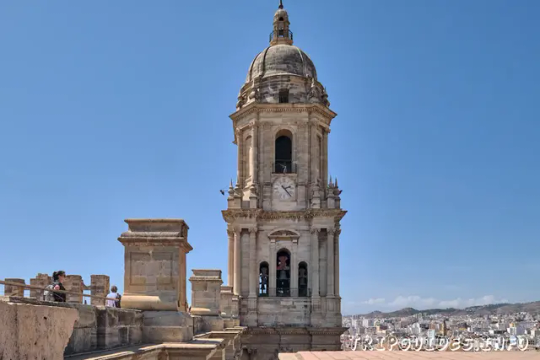

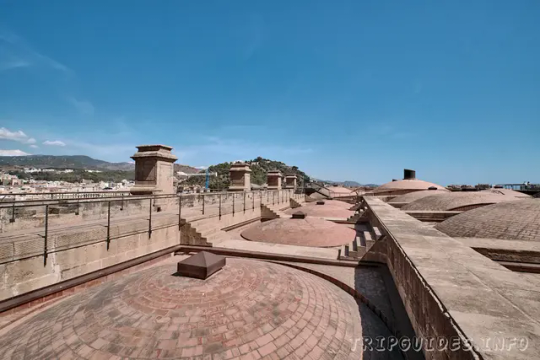
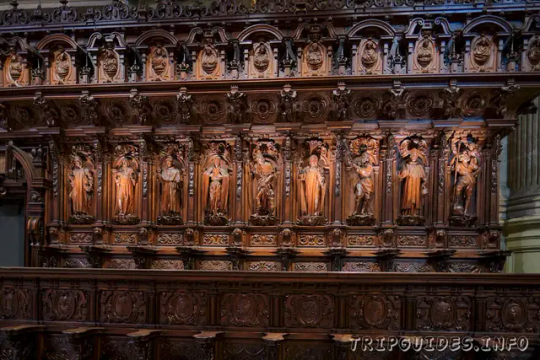
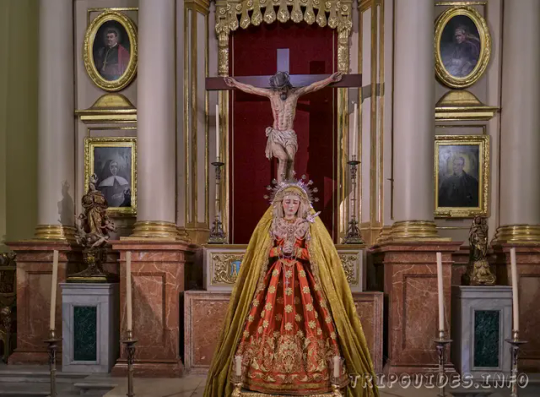

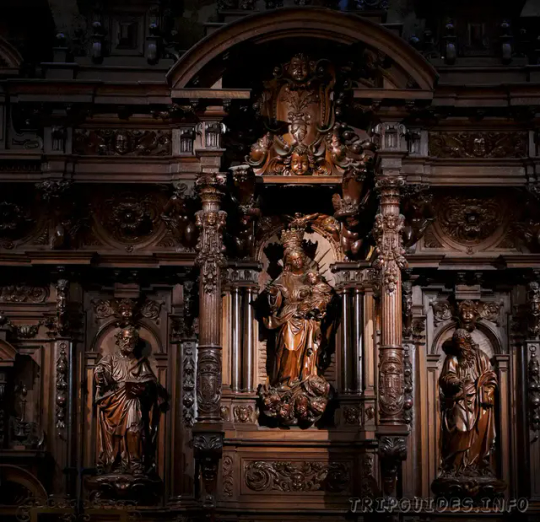

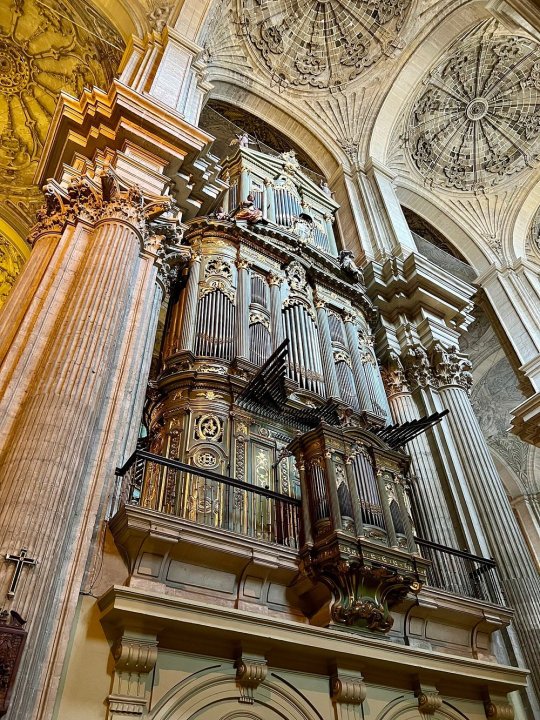
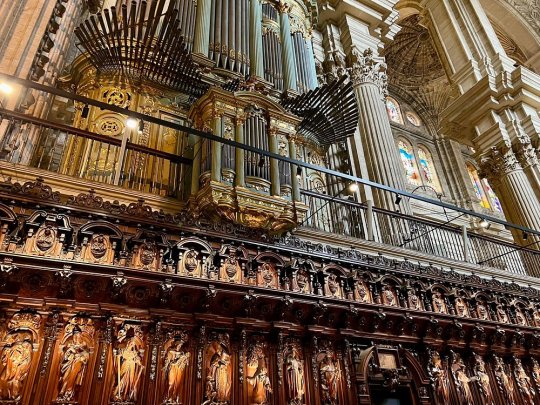

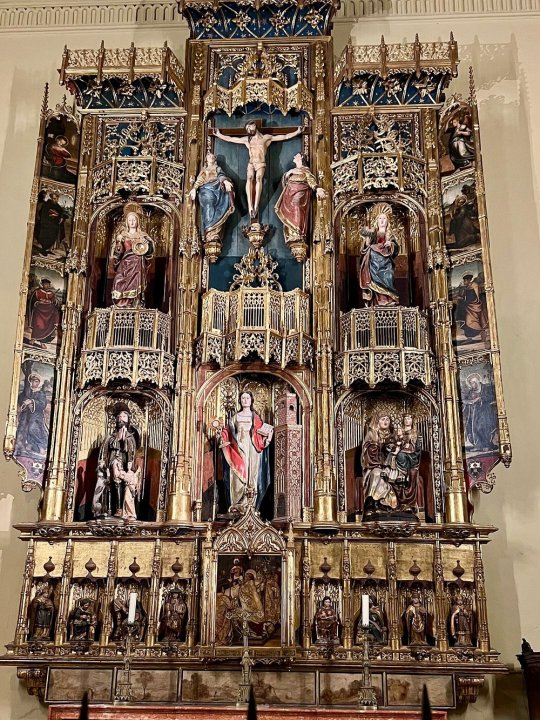



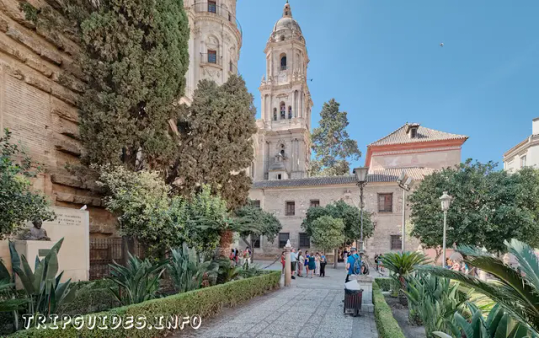
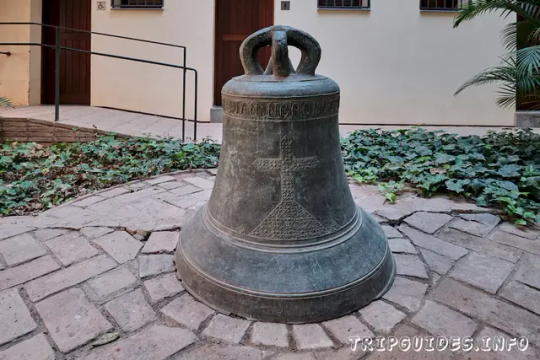
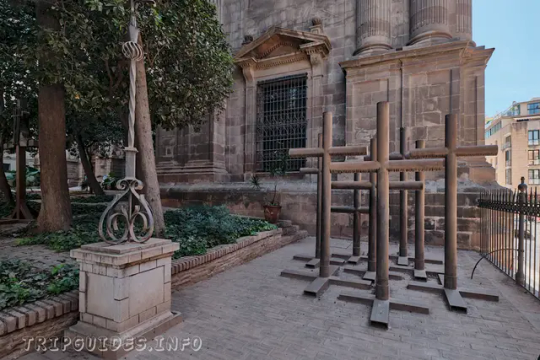

Кафедральный собор Малаги (Базилика Святой Иглесии Катедраль-де-ла-Энкарнасьон ) — главная и самая большая церковь города. Расположен Кафедральный собор на площади Пласа-дель-Обиспо, Испания. Его строительство началось в 1525 году и закончилось в 1782 году, построен он на месте мечети альжама. Долгое время Малагский собор считался вторым по высоте зданием Малаги, а по высоте сводов он уступает лишь собору Пальмы, расположенному на Майорке.
Малагский собор — архитектурный памятник эпохи Возрождения, но проект несколько раз менялся. Основной архитектурный проект бы�� разработан Диего ди Силоэ и Андрес де Вандельвира. Собор строился на протяжении трех веков, поэтому архитектура собора представляет собой смешение разных стилей. Доминирует стиль эпохи Возрождения, но в нем присутствуют элементы готики, барокко и неоклассицизма. Три арки главного портала отделаны мрамором разных цветов. Над каждой дверью размещены изображения главных святых Малаги. Главный фасад собора выполнен в стиле барокко и имеет три арочных портала, над ними расположены барельефы святых покровителей Малаги и сцена Благовещения. По бокам фасада расположено две башни — северная, имеющая высоту 84 метра, и недостроенная южная из-за которой собор в народе называют «Манкита» (Одноручка). Три нефа имеют одинаковую высоту, но средний неф шире остальных, чтобы обеспечить устойчивость конструкции, учитывая их большую высоту, архитектор использовал интересную систему: крестообразные колонны соединены с коринфскими колоннами. Сводчатый потолок имеет многочисленные украшения. В интерьере чувствуется влияние ренессанса и барокко. Многие элементы убранства церкви выполнены из красного дерева и кедра в 17 веке Луисом Ортисом. Украшение партера для хора было сделано Педро де Мена, также его работа — 40 статуй, которые находятся в храме. Две кафедры церкви изготовлены из мрамора Кабра и украшены религиозными мотивами.
Внутри Кафедрального собора хранятся многочисленные произведения искусства религиозной тематики. В боковых часовнях можно увидеть: Плачущая мать: работы Педро де Мена, одного из выдающихся скульпторов эпохи барокко. Большая Дева Розария: кисти Алонсо Кано, знаменитого испанского художника и архитектора. Христос на кресте: Алонсо де Мена, являющийся образцом испанской религиозной скульптуры XVII века.
Внутри собора также находится капелла Святого Причастия, украшенная роскошной позолотой и мрамором. Главный алтарь кафедрального собора был создан архитектором Хосе Мартинесом в стиле ренессанс и декорирован резьбой по дереву. Соборный музей представляет коллекцию религиозного искусства, включая редкие манускрипты, литургические предметы и древние скульптуры.
The Malaga Cathedral (Basilica of Santa Iglesia Catedral de la Encarnación) is the main and largest church in the city. The Cathedral is located on the Plaza del Obispo, Spain. Its construction began in 1525 and ended in 1782, it was built on the site of the Aljama mosque. For a long time, the Malaga Cathedral was considered the second tallest building in Malaga, and in terms of the height of its vaults, it is second only to the Palma Cathedral, located in Mallorca.
The Malaga Cathedral is an architectural monument of the Renaissance, but the project has changed several times. The main architectural project was developed by Diego di Siloe and Andres de Vandelvira. The cathedral was built over three centuries, so the architecture of the cathedral is a mixture of different styles. The Renaissance style dominates, but it also contains elements of Gothic, Baroque and Neoclassicism. The three arches of the main portal are decorated with marble of different colors. Above each door are images of the main saints of Malaga. The main façade of the cathedral is made in the Baroque style and has three arched portals, above them are bas-reliefs of the patron saints of Malaga and the scene of the Annunciation. On the sides of the façade are two towers - the northern one, which is 84 meters high, and the unfinished southern one, because of which the cathedral is popularly called "Manquita" (One-handed). The three naves are of the same height, but the middle nave is wider than the others, to ensure the stability of the structure, given their great height, the architect used an interesting system: cross-shaped columns are connected with Corinthian columns. The vaulted ceiling has numerous decorations. The influence of the Renaissance and Baroque is felt in the interior. Many elements of the church decoration were made of mahogany and cedar in the 17th century by Luis Ortiz. The decoration of the parterre for the choir was made by Pedro de Mena, and his work also includes 40 statues that are in the temple. The two pulpits of the church are made of Cabra marble and decorated with religious motifs.
The interior of the Cathedral contains numerous works of art with religious themes. In the side chapels you can see: The Weeping Mother: by Pedro de Mena, one of the most important sculptors of the Baroque era. The Great Virgin of the Rosary: by Alonso Cano, a famous Spanish artist and architect. Christ on the Cross: by Alonso de Mena, an example of Spanish religious sculpture of the 17th century.
The interior also contains the Chapel of the Blessed Sacrament, decorated with sumptuous gilding and marble. The main altar of the Cathedral was created by the architect José Martínez in the Renaissance style and decorated with wood carvings. The Cathedral Museum presents a collection of religious art, including rare manuscripts, liturgical objects and ancient sculptures.
Источник:/tripguides.info/spain/malaga/sight/sobor/,//t.me/borderlesstravel,/planeta.turtella.ru/spain/malaga/p1533424, /www.iguana.ws/ malaga-religiya-55316/, //www.tripadvisor.ru/Attraction_Review-g187438-d240307-Reviews-Malaga_Cathedral-Malaga_ Costa_del _ Sol _Province_of_Malaga_Andalucia.html.
#Испания#Кафедральный собор Малаги#Базилика Святой Иглесии Катедраль-де-ла-Энкарнасьон#история#архитектура#готика#барокко#неоклассицизм#ренессанс#орган#алтарь#статуи#капелла#Spain#Basilica of Santa Iglesia Catedral de la Encarnación#Malaga Cathedral#history#Architecture#medieval#Renaissance#Gothic#Baroque#Neoclassicism#altar#organ#Statues#Chapel
213 notes
·
View notes
Text
The Birth of Charles II of Spain Fanart

Warning: This story contains some artistic license
The Queen's pregnancy was approaching its end and had become a matter of utmost importance. The future of the Monarchy depended on this event. On Sunday, November 6, everything seemed to be ready. The doctors and physicians were on alert; the Queen's confessor was near her, and the Chief Steward of her Household was carefully reviewing the arrangement of the items in the birth chamber. To guarantee the success of the event, all the holy relics that were in the Palace and others brought from El Escorial and other places had been arranged in order. There was the staff of Saint Dominic of Silos that the Order of Saint Dominic had brought, the ribbon of Saint John Ortega, from the Order of the Hieronymites; the incorrupt bodies of Saint Isidore and Saint Diego de Alcalá; the image of the Virgin of Solitude and the one so venerated by the royal family, Our Lady of Atocha. It is not easy to find a space so holy and sacred. Everything, then, was ready, the things of the earth arranged to implore God's pleasure. At noon, after a frugal lunch, Philip IV retired to his chambers. At the same time, While eating, Queen Mariana suddenly felt intense pain in her abdomen, realizing that she was about to give birth. She quickly left the table and hurried to the Tower Chamber.
King Philip went straight to his study while looking at Prospero’s portraits. He entered his study, sat down, and began to write to answer the last letter of Sor Maria de Agreda. He wrote with a deep sigh and tears in his eyes.
“ With the long illness of my son, and the continuous help I was giving in his room, I have not answered your letter of the last month...I assure you that what has most exhausted me, more than this loss, is to see clearly that I have vexed God and he sent this punishment to castigate my sins...
(The king reminisces his cherished memories with Felipe Prospero while writing this letter)
Help me as a friend with your prayers to placate God’s just anger and beg Our Lord that, as he took my son from me, He may make his light shine on the Queen, whose confinement we await hourly, and give her good health and guard what is to be born, if his will, for otherwise I do not wish it...
Back in the Tower Chamber, Queen Mariana cries in agony as she is delivering her baby. The royal midwife Ines Ayala told Queen Mariana to push harder. Five other doctors were present at this event in case of emergency. One of those doctors was Dr Bravo. While the Queen was giving birth, the courtiers and Infanta Margarita looked on.
Ah, Sor Maria, If I had succeeded in following your teachings, perhaps I would not have found myself thus. Pray to our Lord that he may open his eyes, that I may perform his holy will in all things... There is nothing new in the English situation. I, thank God am in good health...
At this point, King Philip was interrupted by a courtier who delivered the news and told the events occurring in the Tower Chamber. King Philip was anxious about the future that lay within a few hours. He prayed heavily to God, asking him to deliver him a son. All could imagine the impatience of the Royal Court of Madrid and Europe, waiting for an outcome of this event. As hours passed, Queen Mariana was still in labor, and the doctors argued over natural forms of treatment. They were anxious as the Queen and the child’s life was at stake.
Dr. Bravo proposed a theory: In the past, Queen Mariana had difficult experiences giving birth to her children. At the birth of Maria Ambrosia, Felipe Prospero, and Fernando Tomas, The Queen had terrible epileptic seizures, and the infants died or lived for a short time. On the other hand, at the birth of Infanta Margarita, the only child to survive, The Queen had been perfectly well. Now why was this? The reason is simple: Just before Infanta Margarita was born, Queen Mariana had suffered several violent nosebleeds. Therefore, what she requires now is to be bled.
Some doctors disagreed, warning that the proposed action could endanger the Queen and her child. Concerned, Queen Mariana asked the doctors if there were any alternative procedures. The doctors offered different opinions, while Dr. Bravo defended his proposal. As the debate continued, Mariana went into labor with the assistance of Ines Ayala. The infant cries and is alive. The birth of the infant brought joy to all. King Philip became a father once again. When the courtier informed King Philip of the birth, he was overjoyed and immediately visited the tower chamber to see his newborn son. King Philip joyfully held his son and proudly showed him to the Queen and his daughter. When the courtier informed King Philip of the birth, he was delighted and immediately visited the tower chamber to see his newborn son. King Philip joyfully held his newborn son and showed him to the Queen and his daughter.
Sources:
Carlos, A king who would not die by John Langdon Davis
Happy Birthday, Charles II of Spain!
#all I did is just combine these stories together#history#mariana de austria#spain#art#charles ii of spain#house of habsburg#17th century#habsburg#carlos ii#please like and reblog#my art#Mariana's art#happy late birthday#sorry it took me so long#my cute baby#margarita#margarita maria#philip iv#look at them#i love them so much#they are so cute#espana#kingdom of spain#madrid spain#monarquía española#spanish empire#baroque fashion#baroque#artists on tumblr
74 notes
·
View notes
Text
Today, the Church remembers Saint Dominic (Spanish: Santo Domingo), (8 August 1170 – 6 August 1221 A.D.), a Castilian priest and founder of the Dominican Order.
Ora pro nobis.
In the earliest narrative source, by Jordan of Saxony, Dominic's parents are named Felix Guzman and Juanna of Aza. The story is told that before his birth his barren mother made a pilgrimage to the Abbey at Silos, and dreamt that a dog leapt from her womb carrying a flaming torch in its mouth, and "seemed to set the earth on fire." This story drew resonance from the fact that his order became known, after his name, as the Dominican order, Dominicanus in Latin which a play on words interpreted as Domini canis: "Dog of the Lord." Jordan adds that Dominic was brought up by his parents and a maternal uncle who was an archbishop.
The failure to name his parents is not unusual, since Jordan wrote a history of the Order's early years, rather than a biography of Dominic. A later source, still of the 13th century, also gives their names as Juana and Felix. Nearly a century after Dominic's birth, a local author asserted that Dominic's father was "vir venerabilis et dives in populo suo" ("an honoured and wealthy man in his village"). The travel narrative of Pero Tafur, written circa 1439 (about a pilgrimage to Dominic's tomb in Italy), states that Dominic's father belonged to the family de Guzmán, and that his mother belonged to the Aça or Aza family.
Dominic was educated in the schools of Palencia (they became a university soon afterwards) where he devoted six years to the arts and four to theology. In 1191, when Spain was desolated by famine, young Dominic gave away his money and sold his clothes, furniture and even precious manuscripts to feed the hungry. Dominic reportedly told his astonished fellow students, "Would you have me study off these dead skins, when men are dying of hunger?" In 1194, around age twenty-five, Dominic joined the Canons Regular in the canonry in the Cathedral of Osma, following the rule of Saint Augustine.
Around 1205, Dominic, along with Diego de Acebo, began a program in the south of France, to convert the Cathars, a Christian religious sect with gnostic and dualistic beliefs, which the Roman Catholic Church deemed heretical. As part of this, Catholic-Cathar public debates were held at Verfeil, Servian, Pamiers, Montréal and elsewhere. Dominic concluded that only preachers who displayed real sanctity, humility and asceticism could win over convinced Cathar believers. However, even Dominic managed only a few converts among the Cathars.
In 1215, Dominic established himself, with six followers, in a house given by Peter Seila, a rich resident of Toulouse. Dominic saw the need for a new type of organization to address the spiritual needs of the growing cities of the era, one that would combine dedication and systematic education, with more organizational flexibility than either monastic orders or the secular clergy. He subjected himself and his companions to the monastic rules of prayer and penance; and meanwhile Bishop Foulques gave them written authority to preach throughout the territory of Toulouse.
In the same year, the year of the Fourth Lateran Council, Dominic and Foulques went to Rome to secure the approval of the Pope, Innocent III. Dominic returned to Rome a year later, and was finally granted written authority in December 1216 and January 1217 by the new pope, Honorius III for an order to be named "The Order of Preachers" ("Ordo Praedicatorum", or "O.P.," popularly known as the Dominican Order).
Blessed Cecilia Caesarini, who was received by Dominic into his new order, in her old age described him as "...thin and of middle height. His face was handsome and somewhat fair. He had reddish hair and beard and beautiful eyes ... His hands were long and fine and his voice pleasingly resonant. He never got bald, though he wore the full tonsure, which was mingled with a few grey hairs."
Although he traveled extensively to maintain contact with his growing brotherhood of friars, Dominic made his headquarters in Rome. In 1219, Pope Honorius III invited Dominic and his companions to take up residence at the ancient Roman basilica of Santa Sabina, which they did by early 1220. Before that time the friars had only a temporary residence in Rome at the convent of San Sisto Vecchio, which Honorius III had given to Dominic circa 1218, intending it to become a convent for a reformation of nuns at Rome under Dominic's guidance. The official foundation of the Dominican convent at Santa Sabina with its studium conventuale, the first Dominican studium in Rome, occurred with the legal transfer of property from Pope Honorius III to the Order of Preachers on 5 June 1222, though the brethren had taken up residence there already in 1220. The studium at Santa Sabina was the forerunner of the studium generale at Santa Maria sopra Minerva. The latter would be transformed in the 16th century into the College of Saint Thomas and then in the 20th century into the Pontifical University of Saint Thomas Aquinas, Angelicum sited at the convent of Saints Dominic and Sixtus.
In the winter of 1216–1217, at the house of Ugolino de' Conti, he first met William of Montferrat, Dominican friar, afterwards a close friend. According to Guiraud, Dominic abstained from meat, "observed stated fasts and periods of silence", "selected the worst accommodations and the meanest clothes", and "never allowed himself the luxury of a bed". "When travelling, he beguiled the journey with spiritual instruction and prayers". Guiraud also states that Dominic frequently traveled barefoot and that "rain and other discomforts elicited from his lips nothing but praises to God".
Dominic arrived in Bologna on 21 December 1218. A convent was established at the Mascarella church by the Blessed Reginald of Orleans. Soon afterwards they had to move to the church of San Nicolò of the Vineyards. Dominic settled in this church and held here the first two General Chapters of the order.
Dominic died at the age of fifty-one, according to Guiraud "exhausted with the austerities and labours of his career". He had reached the convent of St Nicholas at Bologna, Italy, "weary and sick with a fever". Guiraud states that Dominic "made the monks lay him on some sacking stretched upon the ground" and that "the brief time that remained to him was spent in exhorting his followers to have charity, to guard their humility, and to make their treasure out of poverty". He died at noon on 6 August 1221. His body was moved to a simple sarcophagus in 1233. Under the authority of Pope Gregory IX, Dominic was canonized in 1234.
O God of the prophets, you opened the eyes of your servant Dominic to perceive a famine of hearing the word of the Lord, and moved him, and those he drew about him, to satisfy that hunger with sound preaching and fervent devotion: Make your Church, dear Lord, in this and every age, attentive to the hungers of the world, and quick to respond in love to those who are perishing; through Jesus Christ our Lord, who lives and reigns with you and the Holy Spirit, one God, forever and ever.
Amen.
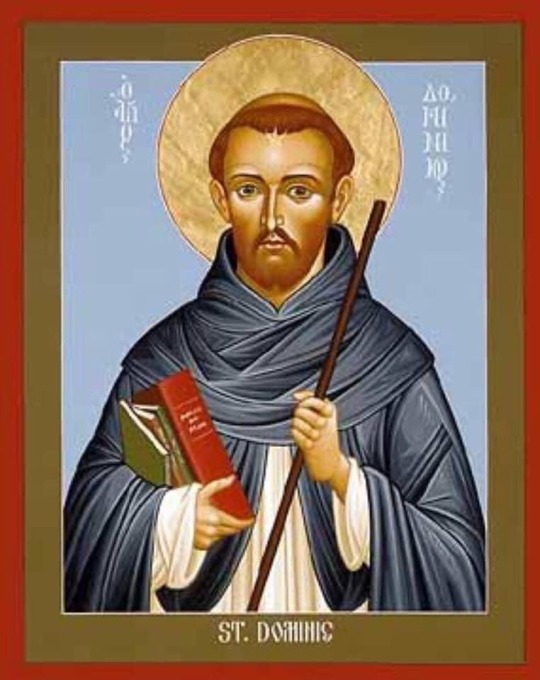
3 notes
·
View notes
Text
São Domingos de Gusmão
Sacerdote fundador da Ordem dos Pregadores (Dominicanos). (1170-1221). Canonizado por Gregório IX no dia 3 de julho de 1234.
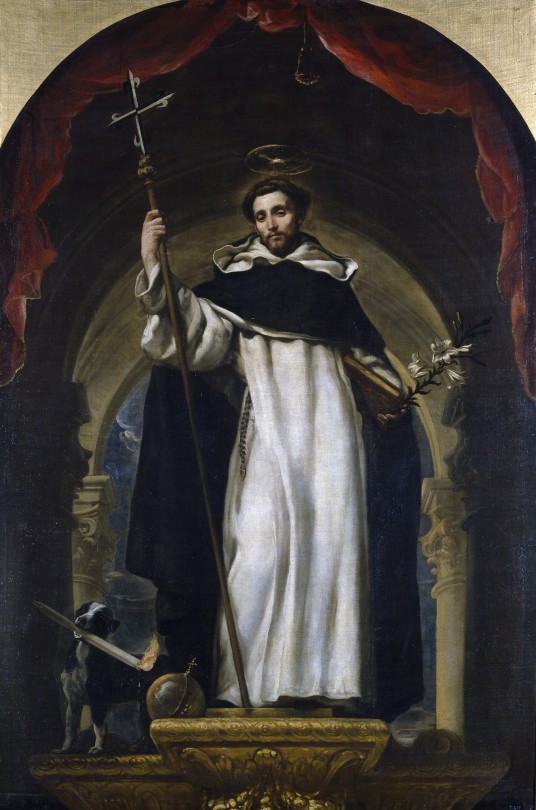
Domingos (ou Dominique) nasceu no ano de 1170, em Caleruega, pequena localidade na Velha Castelha. O pai, Félix de Gusmão, pertencia a uma família de alta linhagem na Espanha; a mãe era Joana de Aza. Antes de Domingos nascer, sua mãe, em sonho misterioso, viu um cão que trazia na boca uma tocha acesa, de que irradiava luz sobre o mundo inteiro. Efetivamente, São Domingos veio a ser uma luz extraordinária de caridade e de zelo apostólico, que dissipou grande parte das trevas das heresias e restabeleceu a verdade em milhares de corações vacilantes. Domingos, foi o nome dado à criança, devido à uma devoção que a mãe do santo tinha com São Domingos de Silos, do qual um dia teve uma aparição, comunicando-lhe os planos divinos em referência ao recém-nascido. A esse aviso extraordinário, os pais corresponderam com esmerada atenção na educação do filho. Domingos, pequeno ainda, deu provas de inclinação declaradíssima às coisas de Deus.
Seis anos contava o menino quando os pais o confiaram à direção de um tio, reitor de uma igreja em Gumyel. Sete anos passou Domingos na escola daquele sacerdote, aprendendo, além das primeiras letras, como sejam, acolitar, enfeitar os altares e cantar no coro. Terminado este curso prático, transferiu-se para Valência, cidade episcopal no reino de Leon, onde existia uma universidade que mais tarde, em 1217, passou para Salamanca.
Durante o tempo dos estudos em Valência, isto é, durante seis anos, dedicou-se à arte retórica, além da filosofia e teologia. Acompanharam-lhe os trabalhos científicos às práticas da piedade, inclusive, severas penitências. Retraído por completo do mundo, visitava somente os pobres e doentes, protegia as viúvas e órfãos. Por ocasião de uma grande fome, vendeu os livros para poder socorrer os necessitados. Certa vez, ofereceu sua própria pessoa para resgatar um jovem que caíra nas mãos dos mouros.
A caridade de Domingos, não satisfeita com as obras corporais de misericórdia, estendia-se principalmente às necessidades espirituais do próximo. Para este fim, desenvolveu um zelo extraordinário, como pregador. O primeiro fruto deste labor apostólico, foi a conversão do amigo e companheiro dos estudos, Conrado, que mais tarde entrou para a ordem de Cister, elevado posteriormente à dignidade de Cardeal da Santa Igreja.
Domingos contava apenas vinte e quatro anos e era considerado um dos mais competentes mestres da vida interior. Dom Diego de Asebes, bispo de Osma, conhecendo os brilhantes dotes de Domingos, convidou-o a incorporar-se ao cabido da diocese, esperando desta aquisição uma reforma salutar do clero. O prelado não se viu iludido nas suas previsões. Domingos, em pouco tempo, foi objeto da admiração de todos, como modelo exemplaríssimo em todas as virtudes cristãs.
Como cônego de Osma, Domingos percorreu diversas províncias da Espanha, pregando por toda a parte a palavra de Deus, pela conversão dos pecadores, cristãos e maometanos. Uma das conversões mais sensacionais que Deus operou por intermédio de Domingos foi a de Reiniers, célebre heresiarca, que mais tarde tomou o hábito dos frades dominicanos.
Domingos não era ainda sacerdote. Do bispo de Osma recebeu a unção sacerdotal, continuando depois a missão apostólica de pregador. Quando, em 1224, por ordem do rei Afonso de Castelha, o bispo de Osma foi à França na qualidade de embaixador real, a fim de tratar dos negócios matrimoniais do príncipe herdeiro Fernando com a princesa de Lussignan, Domingos acompanhou-o. Na província de Languedoc, puderam de perto observar as horríveis devastações feitas pelos albingenses. Numa segunda viagem que empreenderam, cujo fim era buscar a princesa e entregá-la ao esposo, tiveram o grande desgosto de não a encontrar entre os vivos. Chegaram ainda a tempo de assistir-lhe ao enterro.
Preferiram, então, ficar na França, para dedicar-se à campanha contra os hereges. O bispo Diego, com o consentimento do Papa, ficou três anos na província de Languedoc. Passado este tempo, voltou à diocese.
São Domingos, que foi nomeado superior da Missão, associaram-se doze abades cistercienses. Pouco tempo, porém, durou o trabalho coletivo. Dom Diego voltou à Espanha, os cistercienses retiraram-se para os seus claustros e o próprio Legado pontifício abandonou o solo francês.
Domingos não desanimou, apesar da missão se tornar dificílima e perigosa. Com mais oito companheiros que lhe foram mandados, continuou os trabalhos apostólicos. A inconstância, porém, que encontrou nos coadjutores, fez nele amadurecer a ideia de fundar uma nova Ordem, cujos membros, por um voto, se dedicassem à obra da pregação. Os primeiros que se lhe associaram foram Guilherme de Clairel e Domingos, o Espanhol. Em 1215, a nova comunidade contava já dezesseis religiosos, com seis espanhóis, oito franceses, um inglês e um português.
Para assegurar-se da aprovação pontifícia, Domingos em companhia do bispo de Toulouse foi à Roma e apresentou-se ao Papa Inocêncio III. Coincidiu de ele chegar à capital da Cristandade na abertura do Concílio de Latrão. Opinaram os padres que em vez de aprovar as regras de novas ordens, devia o Concílio dirigir a atenção para as Ordens já existentes e aperfeiçoar-lhes as constituições. Inocêncio III, baseando-se nestas decisões, negou-se, por diversas vezes, em dar aprovação à regra da Ordem fundada por Domingos. Aconteceu, porém, que o Papa teve uma visão, quase idêntica à que lhe fez aprovar a Ordem de São Francisco de Assis, em 1209. Não querendo contrariar a obra do santo homem, deu consentimento à fundação da Ordem, prometendo a Domingos expedir a bula, logo que este tivesse adotado uma regra de ordem já aprovada pela Igreja. Domingos decidiu-se em favor da regra de Santo Agostinho, à qual acrescentou mais algumas constituições, como por exemplo, o silêncio, o jejum e a pobreza.
Quando Domingos, pela segunda vez chegou a Roma, já não encontrou o Papa Inocêncio III, mas o sucessor deste, Honório III. Contrariamente ao que receava, obteve a aprovação da Ordem, que veio a ser chamada Ordem dos Pregadores. Nomeado o primeiro superior, fez a profissão nas mãos do Papa.
Graças à generosidade do bispo de Toulouse e do conde Simão de Montfort, Domingos pode construir o primeiro convento em Toulouse. O número dos religiosos crescera consideravelmente, de modo que Domingos pode introduzir em a novel comunidade e regra recém-aprovada.
Pouco tempo depois, Domingos voltou à Roma e fundou diversos conventos na Itália. Em Roma, conheceu São Francisco de Assis, a quem se tornou um grande amigo. Em 1218 foi a Bolonha fundar um convento, perto da Igreja de Nossa Senhora de Mascarella. Um ano depois, teve Domingos a satisfação de fundar outro na mesma cidade, sendo que este, tempos depois, veio a ser um dos mais importantes da Ordem na Itália.
O exemplo de São Francisco de Assis e o admirável desenvolvimento da Ordem por ele fundada, influiu grandemente no espírito de são Domingos. Como o Patriarca de Assis, introduziu S. Domingos na sua ordem o voto de pobreza em todo o rigor.
São Domingos convocou três capítulos gerais e teve o prazer de ver a Ordem se estabelecer na Espanha, em Toulouse, na Provença e na França toda. Conventos surgiram na Itália, Alemanha e Inglaterra. O próprio fundador mandou emissários à Irlanda, Noruega, Ásia e Palestina.
São Domingos morreu no dia 06 de agosto de 1221, na idade de 51 anos. Numerosos milagres por seu intermédio Deus se dignou de fazer. O Papa Gregório IX inseriu-lhe o nome no catálogo dos Santo, em 23 de julho de 1234. Muito concorreu para o culto de São Domingos na Igreja Católica, a devoção do Santíssimo Rosário, de quem era grande Apóstolo.
A Ordem dos pregadores deu à Igreja, muitos Santos, entre estes o grande São Tomás de Aquino, Santo Alberto Magno, Santa Catarina de Siena, São Vicente Ferrer, o Papa Pio V.
Referências bibliográficas: 1. Na luz Perpétua, 5ª. ed., Pe. João Batista Lehmann, Editora Lar Católico – Juiz de Fora – Minas Gerais, 1959. 2. Oração das Horas – Editora Vozes, Paulinas, Paulus e Ave-Maria, 1996.
0 notes
Text
Criador de For All Mankind revela planos para série spinoff da Apple TV+, Star City
A San Diego Comic-Con está acontecendo agora, e os fãs da Apple TV+ estão esperando ansiosamente a revelação da data de lançamento da 2ª temporada de Silo amanhã. Em outro lugar da conferência, no entanto, outro projeto antecipado da TV+ acaba de receber novos detalhes. Ronald D. Moore, criador de For All Mankind, revelou planos para o próximo spinoff da série: Star City. Steve Weintraub de…

View On WordPress
0 notes
Text
Confina Brasil 2023 encerra visitas técnicas da expedição O fechamento da 4ª e última etapa do ano do Confina Brasil, pesquisa-expedicionária conduzida pela Scot Consultoria, incluiu visitas a confinamentos no Sul do Brasil, com paradas nas cidades de São Ludgero, Urubici, Videira, Fraiburgo e Campo Erê, todas localizadas em Santa Catarina. A "Equipe 1" de pesquisa visitou seis confinamentos ao longo da última semana. Essas visitas destacaram confinamentos com sistemas de trato automatizados, melhoramento genético, cadeia produtiva completa, práticas de reutilização de dejetos na agricultura, com ênfase em nutrição e na criação de raças taurinas. Automação na linha de cocho O Confinamento de Tito Hobold, em Orleans (SC), é um empreendimento que se destaca por suas práticas modernas na criação de gado. Uma das inovações recentes do confinamento é a implementação de um sistema de automação na alimentação dos animais. "Os animais são alimentados com uma dieta que consiste principalmente de milho grão e núcleo peletizado, que contém minerais essenciais", comenta Diego Rossin, médico-veterinário e técnico do Confina Brasil. Uma tubulação passa por cima dos cochos de alimentação, equipada com sensores que monitoram o consumo dos animais. "Quando o gado come, o sistema libera automaticamente mais comida. Isso elimina a necessidade de tratos manuais aumentando a eficiência operacional do confinamento", completa Diego. Outro confinamento automatizado, o São Marcelo, localizado em Fraiburgo (SC), possui uma capacidade estática para abrigar mil bovinos. A gestão implementou um sistema de alimentação que é semelhante ao utilizado em granjas de suínos, adaptado para o gado. Esse sistema envolve o fornecimento de oito tratos diários, nos quais a quantidade de alimento é ajustada para cada baia, garantindo uma alimentação equilibrada. Além disso, o piso vazado das baias permite a coleta dos dejetos dos bovinos em uma fossa, que é tratada com bactérias e posteriormente utilizada na agricultura, fechando o ciclo de produção", destaca Rossin. Atenção à nutrição O confinamento de Tito Hobold também implementou um sistema de mistura de ração, com máquina que mistura grãos inteiros, casca de soja e núcleo peletizado na proporção necessária para atender às necessidades nutricionais dos bovinos. Essa mistura é armazenada em silos verticais localizados do lado de fora do galpão e está conectada às tubulações que alimentam os cochos. No Confinamento São Marcelo, a dieta é composta principalmente por milho moído, aveia laminada e núcleo. Por se tratar de uma região produtora de gramíneas de inverno, a aveia é utilizada de maneira estratégica em substituição de parte do milho, e se encaixa perfeitamente em dietas com baixa inclusão de volumoso, pois, além de contribuir com a fibra para manutenção do ambiente ruminal, apresenta elevado teor de FDN, minimizando os riscos de distúrbios metabólicos. Programa de melhoramento genético Localizado em Urubici (SC), o Confinamento Morro do Campestre conta com um projeto de melhoria genética liderado por Arildo, proprietário do confinamento. O intuito é de enfrentar um desafio na pecuária local: a diversidade genética dos rebanhos. "Identificando essa preocupação, Arildo e sua equipe decidiram agir. Eles estão desenvolvendo um programa de integração com outros produtores locais. O programa oferece suporte aos produtores participantes. Isso inclui o fornecimento de medicamentos, protocolos de inseminação e orientação nutricional", conta Diego. O objetivo desse programa é melhorar a qualidade genética do gado na região, tornando a produção mais eficiente e lucrativa para os produtores. O objetivo é a padronização genética do rebanho, podendo resultar em bovinos de melhor qualidade e maior competitividade no mercado. Cadeia produtiva completa O município de Videira (SC) abriga o Confinamento Brancalione, empreendimento que possui todas as etapas da cadeia produtiva da carne. A propriedade trabalha com o sistema
intensivo abrigando as principais raças bovinas, como Hereford, Braford e Angus, além de um frigorífico próprio. O diferencial é que a carne produzida é destinada à boutique de carne localizada na fazenda. "O confinamento tem como objetivo principal abastecer as linhas de abate de seu frigorífico, que acontece apenas às segundas-feiras. Dentro da fazenda, a carne é processada e embalada, sendo encaminhada para a boutique da família", conta Jayne Costa, zootecnista e técnica do Confina Brasil. Além disso, a boutique oferece uma série de cursos relacionados à cadeia produtiva da carne. Os cursos abrangem temas como mercado, nutrição e churrasco, atraindo tanto pecuaristas locais quanto entusiastas da carne. Com isso, o cronograma de visitas da quarta edição do Confina Brasil terminou. Durante essa edição, especialistas percorreram um extenso itinerário que incluiu estados como São Paulo, Paraná, Minas Gerais, Goiás, Mato Grosso do Sul, Mato Grosso, Tocantins, Pará, Maranhão, Bahia, Rio Grande do Sul e Santa Catarina. Com o fim das visitas, o próximo passo é a produção do benchmarking, relatório comparativo da Scot Consultoria que envolve as informações coletadas em todas as propriedades, visando explorar a realidade e divulgar boas práticas e tendências dos sistemas intensivos de criação de gado de corte brasileiros. Acompanhe o Confina Brasil nas redes sociais para checar de perto todos os detalhes da última rota de visitas e não perder o lançamento do benchmarking 2023! Em 2023, o Confina Brasil tem apoio de grandes empresas e entidades do agronegócio: São patrocinadores "Ouro": · Casale · Elanco · FS Bioenergia · Nutron No patrocínio "Prata", o apoio é da Associação Brasileira de Angus. Na categoria montadora, a expedição conta com a parceria da Mitsubishi. São parceiros institucionais a Embrapa Pecuária Sudeste, Embrapa Agricultura Digital e a Universidade Federal de São Carlos (UFSCAR). Quer acompanhar mais a fundo a jornada dos profissionais do Confina Brasil pelo país? Basta acessar o perfil oficial do projeto no Instagram: @confinabrasil, além do site confinabrasil.com.
0 notes
Text
SAINT OF THE DAY (August 8)
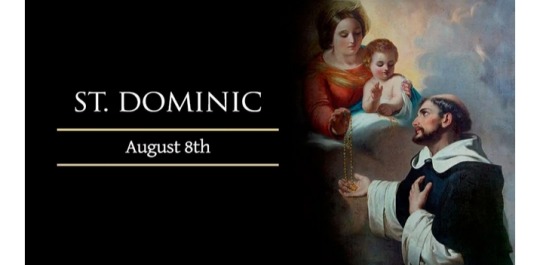
On August 8, the Catholic Church celebrates the feast day of St. Dominic de Guzman, who helped the cause of orthodoxy in the medieval Church by founding the Order of Preachers, also known as Dominicans.
“This great saint reminds us that in the heart of the Church, a missionary fire must always burn,” Pope Benedict XVI said in a February 2010 General Audience talk on the life of St. Dominic.
"In his life," the Pope said, “the search for God's glory and the salvation of souls went hand in hand.”
Born on 8 August 1170 in Caleruega, Spain, Dominic was the son of Felix Guzman and Joanna of Aza, members of the nobility.
He was named after Saint Dominic of Silos.
His mother would eventually be beatified by the Church, as would his brother Manes who became a Dominican. The family's oldest son Antonio also became a priest.
Dominic received his early education from his uncle, who was a priest, before entering the University of Palencia where he studied for ten years.
In one notable incident from this period, he sold his entire collection of rare books to provide for the relief of the poor in the city.
After his ordination to the priesthood, Dominic was asked by Bishop Diego of Osma to participate in local church reforms.
He spent nine years in Osma, pursuing a life of intense prayer, before being called to accompany the bishop on a piece of business for King Alfonso IX of Castile in 1203.
While traveling in France with the bishop, Dominic observed the bad effects of the Albigensian heresy, which had taken hold in southern France during the preceding century.
The sect revived an earlier heresy, Manicheanism, which condemned the material world as an evil realm not created by God.
Dreading the spread of heresy, Dominic began to think about founding a religious order to promote the truth.
In 1204, he and Bishop Diego were sent by Pope Innocent III to assist in the effort against the Albigensians, which eventually involved both military force and theological persuasion.
In France, Dominic engaged in doctrinal debates and set up a convent whose rule would eventually become a template for the life of female Dominicans.
He continued his preaching mission from 1208 to 1215, during the intensification of the military effort against the Albigensians.
In 1214, Dominic's extreme physical asceticism caused him to fall into a coma, during which the Virgin Mary is said to have appeared to him and instructed him to promote the prayer of the Rosary.
Its focus on the incarnation and life of Christ directly countered the Albigensian attitude towards matter as evil.
During that same year, Dominic returned to Tolouse and obtained the bishop's approval of his plan for an order dedicated to preaching.
He and a group of followers gained local recognition as a religious congregation, and Dominic accompanied Tolouse's bishop to Rome for an ecumenical council in 1215.
The council stressed the Church's need for better preaching but also set up a barrier to the institution of new religious orders.
Dominic, however, obtained papal approval for his plan in 1216 and was named as the Pope's chief theologian.
The Order of Preachers expanded in Europe with papal help in 1218.
The founder spent the last several years of his life building up the order and continuing his preaching missions, during which he is said to have converted some 100,000 people.
After several weeks of illness, St. Dominic died in Italy on 6 August 1221.
He was canonized by Pope Gregory IX on 13 July 1234.
He is the patron saint of astronomers, natural scientists, falsely accused people, the Dominican Republic, and other locales throughout the world.
0 notes
Text
Buenavista del Norte

Descripción del municipio
El término municipal de Buenavista del Norte se halla en la vertiente noroccidental de la isla de Tenerife, cuenta con una una superficie de 67,42 km²; y la capital municipal se emplaza a una altitud de 90 metros sobre el nivel del mar. Buenavista del Norte es uno de los pocos municipios de Canarias que cuenta con Acta Fundacional propia, fechada en el año 1513. Pero está constatado documentalmente que el 11 de marzo de 1498 ya se reconocía la sustantividad de Buenavista, pues Alonso Fernández de Lugo en esa fecha cedió a Diego de Cala unas tierras "situadas en La Fuente del Cuervo, lugar de Buenavista". Gran parte del municipio de Buenavista se encuentra en el área que supone uno de los tres sectores geológicos más antiguos de Tenerife: el macizo de Teno, un espacio formado a partir de las emisiones de múltiples coladas de lava. Con posterioridad, la continua actividad erosiva ha modelado un relieve caracterizado por profundos barrancos, como el de Masca, y grandes acantilados. Estos acantilados pueden ser activos, caso de Los Gigantes, o haber quedado muertos, por el surgimiento de las llamadas islas bajas. El Parque rural de Teno está configurado básicamente por el macizo montañoso de Teno y las zonas que lo rodean. Con una superficie de 8.063,6 hectáreas, que se reparte con los municipios limítrofes de Los Silos, El Tanque y Santiago del Teide, el 69,4 % de la superficie del parque se extiende en Buenavista del Norte y constituye un enclave dentro de la oferta de turismo alternativo para la isla de Tenerife.
Más información



Símbolos de Buenavista del Norte
Bandera

El Ayuntamiento de Buenavista del Norte usa de forma oficiosa como enseña del municipio, una bandera dividida verticalmente en dos mitades, verde al asta y blanca al vuelo, con el escudo heráldico municipal en el centro.
Escudo heráldico
El escudo de Buenavista del Norte es medio partido y cortado. Primero, de azur, faro en su color. Segundo, de sinople, dos saltamontes de oro, pasantes y puestos en palo. Tercero, de plata, cardón de sinople. Bordura de gules con la leyenda “Daute es mi bando. Tenerife mi isla. Buenavista mi nombre” en letras de oro. Al timbre, corona real cerrada. En el primer cuartel, el azur simboliza el mar y el cielo, fieles acompañantes de la villa, en palabras de Viera y Clavijo, y el faro representa al existente en la punta de Teno. En el segundo cuartel, el sinople simboliza la fertilidad de la zona, de la que procede su nombre, y los saltamontes recuerdan la leyenda según la cual la villa se libró milagrosamente de una plaga de este insecto que asoló el resto de la isla en 1659. El cardón representa un ejemplar de 148 m² de superficie que existió en el municipio, hoy desaparecido. El gules de la bordura recuerda el color rojizo de las tierras de la zona de El Palmar, mientras que la leyenda “Daute es mi bando” alude al reino, bando o menceyato aborigen de tal nombre que tuvo su sede en lo que hoy es el término municipal de Buenavista del Norte.
Aprobación: Orden Consejería de Presidencia del Gobierno de Canarias de 7 de marzo de 1986 (BOC de 10 de marzo).
0 notes
Text
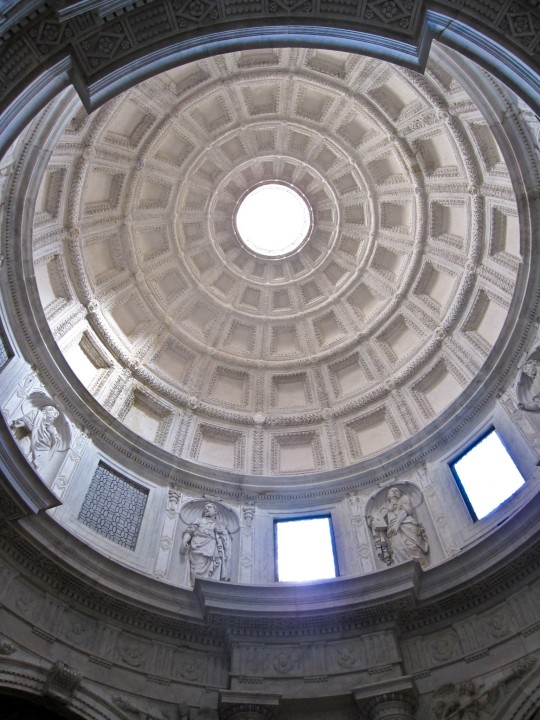

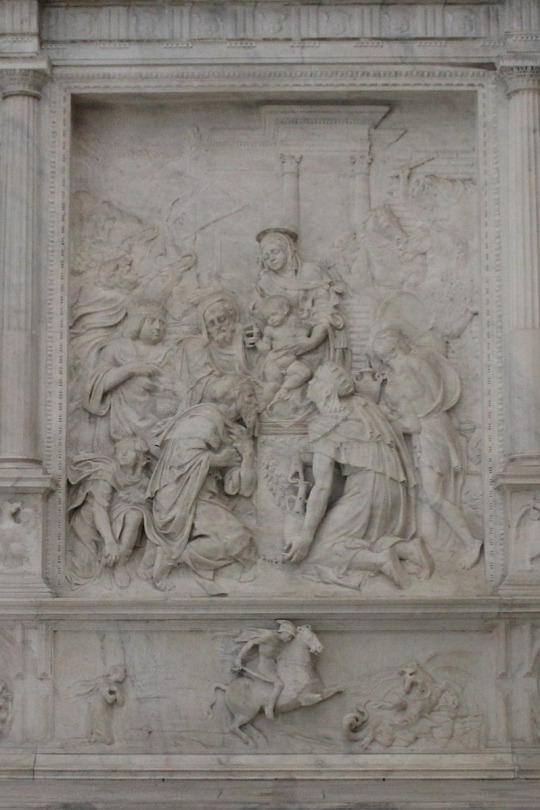

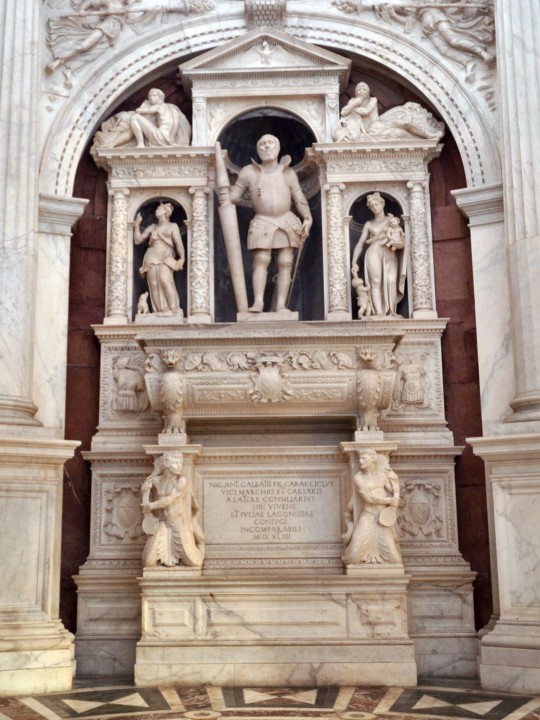
Diego De Siloe e Bartolomé Ordóñez, Altare dell'Epifania (1516)
Annibale Caccavello e Giovanni Domenico D'Auria, Sepolcri di Galeazzo Caracciolo e Nicolantonio Caracciolo (1557-73)
Cappella Caracciolo di Vico, Chiesa di San Giovanni a Carbonara, Napoli.
#Diego De Siloe#Annibale Caccavello#Giovanni Domenico D'Auria#Cappella Caracciolo di Vico#san giovanni a carbonara#napoli#rinascimento#cinquecento#arte rinascimentale#scultura#scultpure#architettura#architecture#marble#art history#arte#art#naples italy#naples#naplesart#campania#sud italia#visit italy#Naples churches#Bartolomé Ordóñez
100 notes
·
View notes
Photo

3.
Diego de Siloe
Holy Family
16th century, wood
40 notes
·
View notes
Photo

The Birth of Saint John the Baptist, Artist unknown, 1515, Art Institute of Chicago: Arms, Armor, Medieval, and Renaissance
This polychromed and gilded relief was probably once part of a large carved altarpiece with scenes from the life of Saint John the Baptist. The tightly swaddled infant Baptist is the center of attention as he is passed between his mother, Saint Elizabeth, and a kneeling attendant. The well-preserved relief combines, a riot of rich colors and pattern in the treatment of fabrics with figures that show a Renaissance impulse towards volume and weight. It reflects the influence of the sculptors Felipe Vigarny and Diego de Siloe, who worked together in Burgos in the early 1520s; the relief may have been made in the region of Burgos. Gift of the Antiquarian Society Size: 103.5 × 99.1 cm (40 3/4 × 39 in.) Medium: Wood, polychromy, and gilding
https://www.artic.edu/artworks/63536/
11 notes
·
View notes
Text
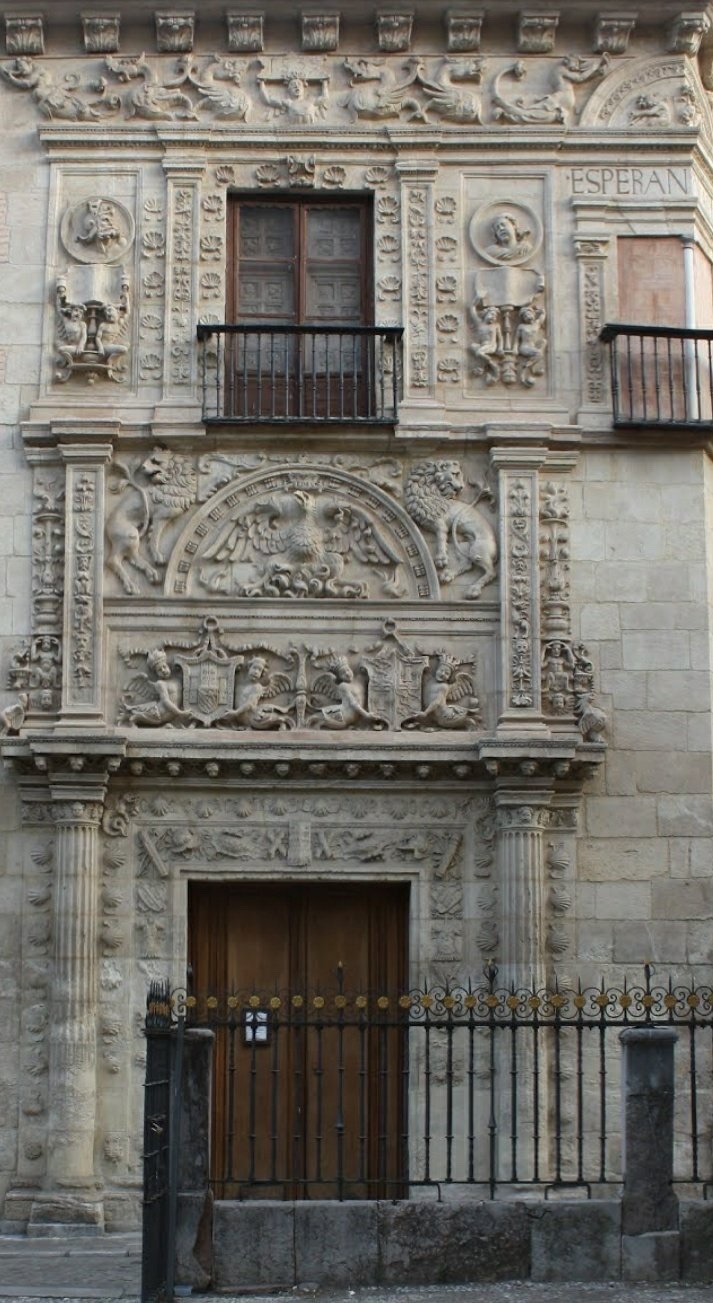
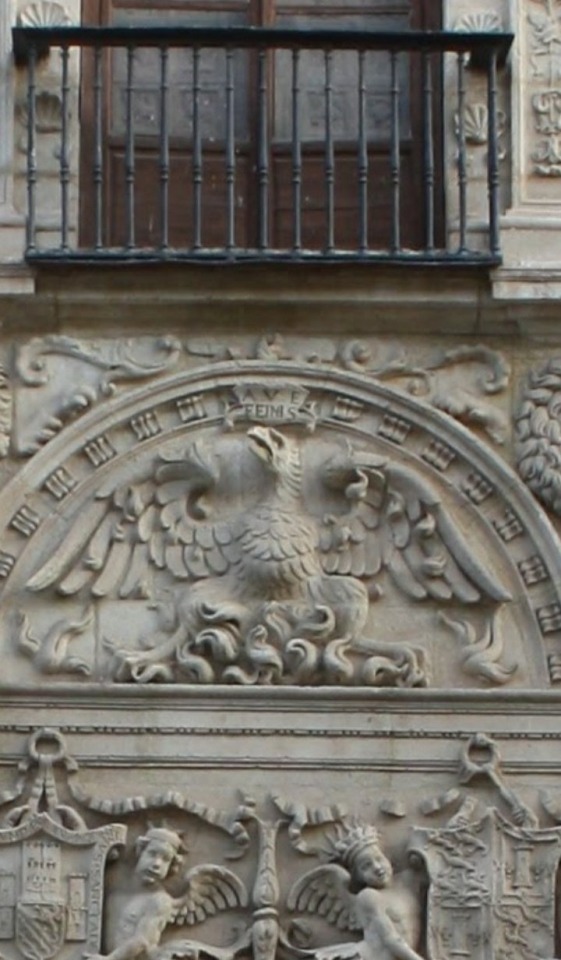

Archaeological and Ethnological Museum of Granada, Spain, located in the Casa de Castril, a Renaissance palace (16th century) that belonged to the family of Hernando de Zafra, secretary of the Catholic Monarchs. The facade is attributed to Sebastián de Alcántara, a disciple of Diego de Siloe.
31 notes
·
View notes
Text
The Birth of Charles II of Spain

Supposed portrait of Charles II as a newborn. Stirling Maxwell Collection (Pollock House, Glasgow), attributed to Martínez del Mazo.
Carlos José, Charles II of Spain, was born on Sunday, November 6, 1661. The news spread quickly throughout the Royal Palace in Madrid, releasing enormous tension barely contained until then. Joy filled all the rooms, as Queen Mariana's pregnancy had come to a happy conclusion. Given the challenges of the previous days and months, this was a significant relief. Just five days earlier, on November 1, 1661, the Feast of All Saints, the crown prince of the monarchy, the beloved and cherished Philip Próspero, had tragically died. His death was a profound loss for Philip IV and his wife, who was in an advanced stage of pregnancy at the time. With the passing of the young prince, the Catholic Monarchy once again faced a lack of direct male heirs, instilling a sense of pessimism and fatalism throughout the Palace and across the cities and kingdoms of the realm. The death of Don Felipe Próspero, who was only four years old, struck the heart of the aged King like a dagger, leading him to believe, with certainty, that God had abandoned him.
Queen Mariana was deeply distressed. She understood her royal husband's feelings well. From her earliest childhood, she had been educated about the reasons for the state and was aware of what dynastic inheritance meant, so she empathized with her husband's dual pain—both providential and political. Additionally, as a mother who had already lost several children, she felt overwhelmed by the painful fate that the Almighty had in store for her, a fate that undoubtedly shaped her harsh and rigid character. The death of Philip Prospero, who was taken from life too soon, was just the latest tragedy in a long series of losses. Indeed, Mariana had endured a profoundly tragic maternal experience.
For all the above reasons, in the days following the death of Philip Prospero, the Queen's pregnancy, which was nearing its end, became a matter of first importance. The future of the Monarchy depended on this event. On Sunday, November 6, everything seemed to be ready. The doctors and physicians were on alert; the Queen's confessor was near her, and the Chief Steward of her Household was carefully reviewing the arrangement of the items in the birth chamber. To guarantee the success of the event, all the holy relics that were in the Palace and others brought from El Escorial and other places had been arranged in order.
There was the staff of Saint Dominic of Silos that the Order of Saint Dominic had brought, the ribbon of Saint John Ortega, from the Order of the Hieronymites; the incorrupt bodies of Saint Isidore and Saint Diego de Alcalá; the image of the Virgin of Solitude and the one so venerated by the royal family, Our Lady of Atocha. It is difficult to find a space so holy and sacred. Everything, then, was ready, the things of the earth arranged in order to implore God's pleasure.
At noon, after a frugal lunch, Philip IV retired to his chambers. At the same time, the Queen felt discomfort and went to her room. The midwife, Doña Inés de Ayala, and the chief physician of the Royal Chamber, Don Andrés Ordóñez, both witnesses of the birth of Doña Mariana in Vienna in 1634, were now assisting her in her sixth birth, the most anticipated of all. Mariana of Austria was then 27 years old. The chronicles say that there was no setback. It was one o'clock in the afternoon on that Sunday, the day of San Leonardo, when, according to the Gazette, “
a very handsome prince with large features, a large head, black hair, and somewhat swollen flesh saw the light of this world .” It was, of course, a very favorable comment, but soon rumors to the contrary spread through the gossip columns of the Villa and Court. That birth was received with joy. At three in the afternoon, when the news had already spread to all corners of the Monarchy and Europe, a sober and elegantly dressed Philip IV in black velvet, left his chamber and, “
accompanied by the Nuncio, the Grand Masters and the Ambassadors ”, headed towards the Palace Chapel in full courtly etiquette. There, the royal procession, presided over by the monarch, sang a solemn Te Deum, thus beginning the festivities that, in honor of the future Charles II, occupied the entire month of November 1661.
#history#mariana de austria#house of habsburg#spain#art#charles ii of spain#habsburg#17th century#carlos ii#please like and reblog#facts people should know#facts#fun facts#interesting facts#childbirth#birth#Happy birthday Charles II of Spain#birth story#The fanart will be delayed sorry#coming soon#baroque
39 notes
·
View notes
Text
LOS HERNÁNDEZ CANARIOS.
EDRA - Origen
LOS HERNÁNDEZ CANARIOS
En la actualidad, 150.000 canarios (un 10 por ciento de la población autóctona) son portadores del apellido Hernández, de los cuales 90.949 nacieron en la provincia de Santa Cruz de Tenerife y 59.250 en la de Las Palmas. Pero lo más importante es que este apellido es mucho más abundante en Canarias que en cualquier otra región del Estado español. Por ejemplo: en Madrid -con una población que triplica (6.500.000) a la de Canarias (2.120.000) y cuyos habitantes, en gran parte proceden de otras provincias españolas (lo que nos permite extrapolar ese censo como promedio español)-, "sólo" hay 74.907 personas apellidadas Hernández, la mitad que en Canarias (datos del INE, 2013).
Veamos por qué sucede esto. En repetidas ocasiones hemos comentado y demostrado que la población guanche, tras la conquista del Archipiélago, quedó en mayoría con respecto a los colonizadores que se asentaron en las Islas tras su sometimiento. También hemos hecho referencia a los múltiples documentos (datas, protocolos notariales, tazmías, actas sacramentales, etc.) donde aparecen centenares de guanches con nombres y apellidos castellanos y portugueses (muchos de ellos Hernández y Hernandes) que ya habían sido bautizados y estaban integrados en la nueva sociedad. De esta manera observamos que, desde el principio, en las propias familias reales guanches ya empieza a proliferar el apellido Hernández. Y así, leyendo a Nicolás Díaz Dorta (1913), en su "Árbol genealógico de la Familia Real indígena de Tenerife", nos encontramos con que, entre otros, Adjoña, el mencey de Abona, fue bautizado como Gaspar Hernández; la princesa Guacimara, hija del Mencey Beneharo de Anaga, recibió el nombre de Ana Hernández; Acaimo, mencey de Tacoronte, se casó con su prima María Hernández, viuda de Diego de Güímar. A su vez, Juan González Benza, hijo o primo del mencey de Adeje, se casó con María Juana Hernández; Hernando de Ibaute, que se supone hijo del mencey de Daute, se casó con Ana Hernández; Asano Imobach (o Pedro Afonso Ibaute) se casó con Chachiñama o Felipa Hernández, infanta de Taoro; Duriman, bautizado como Cristóbal Hernández de Taoro, posible último príncipe heredero de la casa real de Taoro, se casó con Añagua, luego llamada Ana Hernández Tacoronte.
Por su parte, en la nobleza de Gran Canaria vemos que la hija de Guanarteme, la princesa Masequera, fue bautizada como Catalina Hernández Guanarteme. Además, es sabido que parte de la familia real de Gáldar fue trasladada (a consecuencia de la política de desarraigo practicada por la corona de Castilla) a Tenerife y se emparentó con la nobleza guanche. Y así tenemos a Fernando Guanarteme, príncipe de la casa real de Gáldar, casado con Inés Hernández Tacoronte. A su vez, la infanta Collorampa de Taoro, bautizada como María Ana Hernández, se casó con Juan Doramas, conquistador grancanario (probablemente, de él proceden los Oramas tinerfeños). Y entre los más de 150 canarios (guanches de Gran Canaria) -muchos de ellos conquistadores, que fueron datados en Tenerife por el Adelantado Alonso Fernández (o Hernández) de Lugo, especialmente en el Valle de Taoro (fundadores del Realejo)- encontramos a Rodrigo Hernández Guanarteme ("El Cojo"), Luis Hernández y Juan Hernández. (Basado en Gabriel Betancor Quintana, 2002).
Y si ahora prestamos atención a la tazmía (censo poblacional para calcular las reservas de grano en épocas de escasez) de Tenerife (1559), en La Laguna (Aguere), de un total de 1.095 vecinos, 94 se apellidaban Hernández (casi el 10 por ciento, una cifra que coincide con la proporción actual). Asimismo, es sabido que el núcleo fundacional de la capital de la isla se formó en el entorno de la iglesia de La Concepción, antes de trasladar la administración a la Villa de Abajo (plaza del Adelantado), y que muchos de sus vecinos eran guanches.
Y en La Orotava, segunda ciudad en importancia de la isla en aquella fecha, tenemos que de 313 vecinos, 38 tenían el apellido Hernández (el 12 por ciento) y que, curiosamente, 26 de ellos figuraban escritos como Hernándes, debido a la gran influencia portuguesa en toda esa zona de Tenerife (La Orotava, Icod, Garachico, Buenavista, Los Silos...). (Datos de la tazmía de 1559 basados en M. A. Gómez Gómez, R.J. González Zalacaín y J.M. Bello León, 2008).
Pues bien, el análisis final que podemos hacer a la vista de estos datos es que la estadística resulta muy útil cuando se trata de indagar y leer "entre líneas" en la "nebulosa" de la tergiversada Historia que nos han contado. En este sentido, también la genealogía, influenciada por el aislamiento y la endogamia genética (5.265 canarios se apellidan Hernández Hernández, frente a los 750 de Madrid), ha propiciado el que ahora, 518 años después de la conquista, podamos ir conociendo hechos reveladores que nos acercan, cada vez más, a nuestros heroicos antepasados. En definitiva, Hernández, un patronímico que se nos antojaba muy común, ahora se convierte, conocida su diferenciada génesis insular, en un interesante apellido del que gran parte de las decenas de miles de sus portadores canarios (en las Islas y en América) pueden y deben sentirse orgullosos de poseer una más que probable estirpe guanche.
FUENTE
Francisco García-Talavera
Foto: La Pila Verde bautismal del Templo de Santiago de Gáldar, en Gran Canaria, contiene cinco siglos de historias, y fue traída para bautizar a los naturales de la Isla, en especial a miembros de las clases superiores
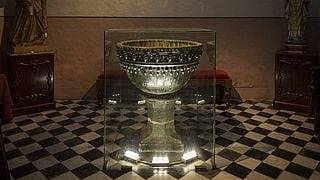
#hernandez#descolonizacion de canarias#canarias#cpi#icc#corte penal internacional#canarias la colonia mas antigua del mundo#onu#naciones unidas#islas canarias#canarias territorio africano ocupado por españa#canarias tiene identidad cultural propia#canarias territorio ocupado por las tropas de ocupacion españolas#canarias territorio ocupado#canarias libre#un#unesco#international court criminal#tribunales internacionales de justicia#historia#history#aborigen canario#aborigen#indigena#indigenous#indigenas canarios#heráldico
1 note
·
View note
Text
My Art Haven
Three artworks for my living room, if money and space were no object – with Bernadine Bröcker, Vastari Co-Founder & CEO
1. John Singer Sargent's Carnation, Lily, Lily, Rose (1885-6)

This is a beautiful work on so many levels, but if I owned it, I would take it out of its frame and have it on an easel. That is how I encountered it once at the conservation studio of the Tate (thanks to Josefina Lopez Ovalle, who showed me around while she was conducting research there on Latin American art). Something about seeing a work on an easel, stripped of the gilded cage, was emotionally impactful and so strong. Also, given the subject matter is so delicate, framed with delicate lighting, it felt so much more spiritual, seen in that way.
2. Ernst Ludwig Kirchner's Street, Berlin (1913)

This is a very different work. I truly felt that the women portrayed by Kirchner had such power and sultry appeal, it always fascinated me. Further, the optical illusions of these works really caught me off guard. What is happening with the environment? What is real, what is imagined? I can keep looking at the work for very long periods of time.
3. Diego de Siloe's Saint Jerome (c. 1555)
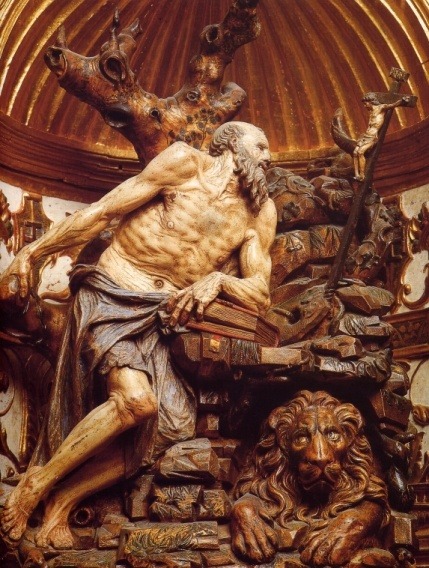
I am not particularly religious but I am always attracted to the Catholic depictions of Saint Jerome (347-420 AD), the scholar with a friendly lion by his side who also experienced humility in the desert. This figuration by Diego Siloe is one of my favourites. The charming lion under the desk, looking hesitantly at his companion from the corner of his eye. The very detailed feet of Saint Jerome and the way his pinky still earmarks a chapter in the book he's reading even though he's clearly going through some kind of agony. It's not your typical living room art work, but I can also look at this for hours on end. I wrote my master's thesis on this Spanish Renaissance artist, and travelled to Burgos specially to see this work in person. It did not disappoint.
#My Art Haven#Vastari#Bernadine Bröcker Wieder#John Singer Sargent#Tate#Josefina Lopez Ovalle#Ernst Ludwig Kirchner#MoMA#Diego de Siloe#Saint Jerome#Sculpture#Painting#Renaissance#Spain#Lion#Women#Burgos#Capilla de los Condestables
0 notes
Photo

Vista de la torre norte y fachada principal de la catedral, Málaga, España 🇪🇸 The Cathedral of Málaga is a Roman Catholic church in the city of Málaga in Andalusia in southern Spain. It is in the Renaissance architectural tradition. The cathedral is located within the limits defined by a now missing portion of the medieval Moorish walls, the remains of which surround the nearby Alcazaba and the Castle of Gibralfaro. It was constructed between 1528 and 1782, following the plans drawn by Diego de Siloe; its interior is also in Renaissance style. (en Málaga Cathedral) https://www.instagram.com/p/Bv8jHF8lstt/?utm_source=ig_tumblr_share&igshid=49ntsdwtykd0
1 note
·
View note